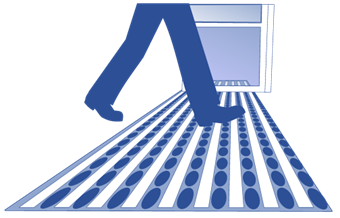Monitor Ice, Frost, and Snow Risks
Icy conditions are among the most significant slip hazards during winter. Managing ice, frost, and snow requires planning and action to ensure that workers remain safe.
- Identify high-risk areas: Focus on areas where ice is most likely to form, such as building entrances, car parks, walkways, sloped areas, and shaded zones.
- Monitor temperatures: Stay updated on weather forecasts to anticipate freezing conditions. This will allow you to take action before ice forms.
- Take preventive measures: If freezing temperatures are predicted, take action early by salting walkways, using grit, or covering walkways with insulating materials. Alternatively, you can divert pedestrians to safer paths while the hazardous areas are treated.
Gritting and De-Icing
Gritting is a widely used and effective method for de-icing outdoor surfaces. Salt or treated grit can help prevent ice formation and melt existing ice or snow. However, it’s important to use it effectively:
- Pre-emptive action: Grit paths and walkways before frost, ice, or snow is expected—ideally in the evening before the frost settles or early in the morning before employees arrive.
- Avoid gritting in heavy rain: If it's raining heavily, grit may be washed away, and you may face challenges if the rain later turns into snow or ice.
- Consider the timing: Be aware of "dawn frost," a phenomenon where the early morning dew freezes on dry surfaces, often making it difficult to predict and treat.
Use Clear Signage and Barriers
To further reduce the risk of slips and trips, use clear signage and physical barriers to guide employees around hazardous areas.
- Warning signs: Display signs that indicate slippery conditions and warn employees to be cautious, especially in areas that may become icy. Make sure to remove them once the hazard has passed.
- Barriers: If possible, close off particularly dangerous walkways and direct pedestrians to safer routes. This is especially important in areas where ice or snow poses a major risk.
What are the most vulnerable areas for winter slips, trips, and falls?
The most vulnerable areas for slips, trips, and falls during winter months are icy pavements and carparks, wet and slippery entryways, and areas with poor lighting. It's crucial to keep these spaces clear of snow and ice and use salt or sand to improve traction and prevent accidents.
Developing a Winter Safety Culture
A winter safety culture at work means creating a place where everyone cares about safety. Open communication about potential hazards is key. People should talk about problems and act before any accidents happen.
Sharing winter safety tips is essential. For example, taking short steps on icy surfaces and being aware of your surroundings can help. Having a system to report potential hazards like icy patches or uncleared walkways is important too. This allows quick action and shows that you care about safety.
Final Thoughts
As we go through winter, it's very important to focus on safety and avoid slips, trips, and falls. We need to know the risks that come with ice and snow. Employers have a big part in keeping us safe by using good lighting and spreading grit on surfaces. Managing rainwater, wearing the right footwear, and training staff are important ideas for preventing accidents. We should create a winter safety culture and have emergency plans ready. By sticking to these best practices and making a safe place, we can lower the chances of accidents and keep the workplace secure for everyone.





